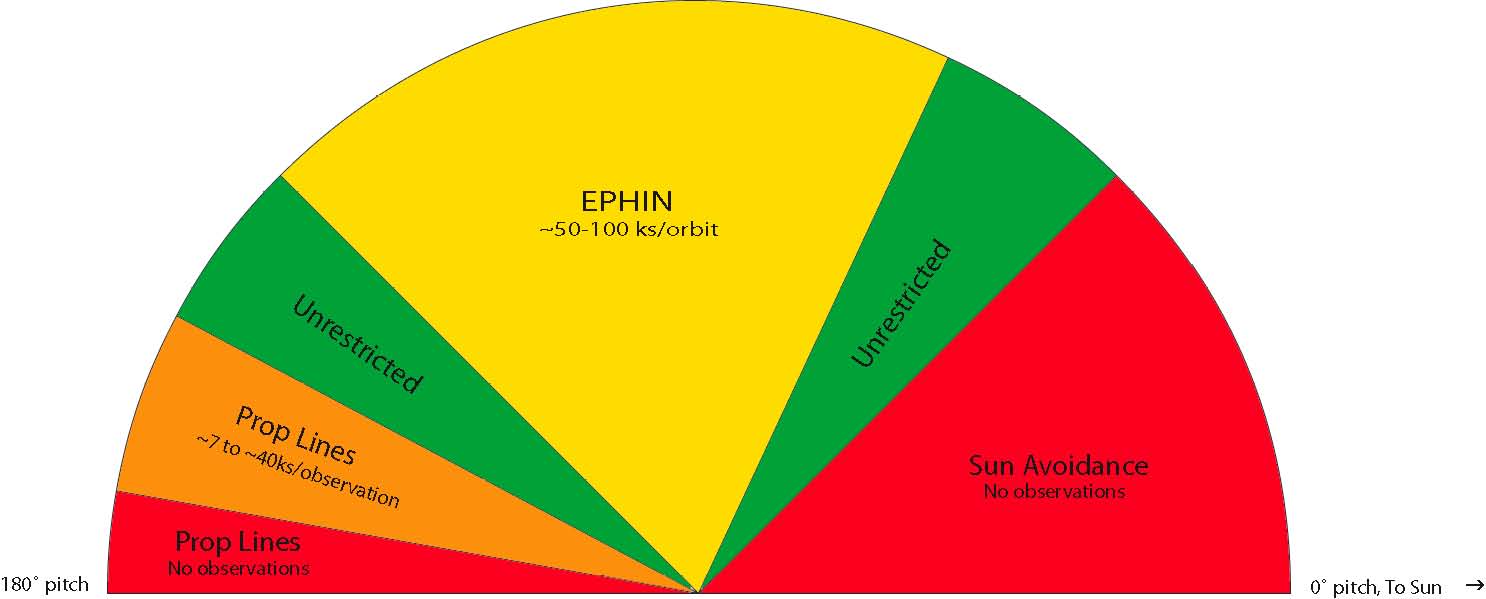As thermal conditions on the spacecraft have changed, some new limitations on observations have been added. In order to avoid overheating the charged particle detector, EPHIN, or excessive cooling of the propellant lines, the maximum length of an exposure is dependent on the pitch angle of the target. As a reminder of the new situation, we have excerpted parts of section 3.3.2 of the AO 8 POG. (Editor)
*** Proposers and observers, however, should check the CXC website for any changes in the restrictions. **** Constraints necessary to ensure the health and safety of the spacecraft and science instruments. Sun avoidance: (cannot be overridden) Restricts viewing to angles larger than 46° from the limb of the Sun. This restriction makes about 15% of the sky inaccessible on any given date, but no part of the sky is ever inaccessible for more than 3 months.

FIGURE 19: Diagram to illustrate ranges of solar pitch angle (the angle between the pointing direction and the satellite-Sun line) within which different observing limitations apply. Table 1 provides quantitative estimates for the observing limitations in the solar pitch angle ranges shown in the drawing.
Pitch angle constraints: Changes in the thermal properties of the spacecraft with time are introducing additional restrictions in the solar pitch angles (i.e., angles between the viewing direction and the direction to the sun, see Figure 19) that can be observed. These restrictions are evolving with time; observers are urged to consult the CXC web pages for the latest developments.
| Angle Range | Restriction | Reason |
| 0 - 45 | No observations | HRMA Sun avoidance |
| 45 - 65 | Unrestricted | |
| 65 - 135 | ~50 - 100 ks orbit, depending on pitch history | EPHIN temperature limitations |
| 135 - 152 | Unrestricted | |
| 152 - 170 | 7 to 40 ks observation, depending on length of previous attitude at low pitch angle | Propulsion line temperature |
| 170 - 180 | No observations | Propulsion line temperature limitations |
The pitch restrictions are of two kinds:
a. The EPHIN detector is subject to possibly degraded performance at
elevated temperatures that may affect its use in safing the
science instruments from high levels of particle
radiation. During long observations at pitch angles of between
approximately 65 and 135 degrees the EPHIN may reach
temperatures that may result in anomalous performance depending
on its prior thermal history. A model of the EPHIN temperature
as a function of pitch profile has been developed that is used
in planning to constrain the maximum EPHIN temperature.
b. Due to occurrences of excessive cooling in propellant lines, we are implementing a restriction against pointing at pitch angles greater than 170 degrees. For Cycle 8 we urge that you carefully consider how to configure your observation such that it does not require a pitch angle greater than 170 degrees. This may be done, for example, by imposing no constraints on the observation, or by checking that the time or roll constraints can be satisfied with the target at angles between 45 and 170 degrees from the sun (subject to the EPHIN-related pitch constraints described above). Even if accepted by the peer review, it may subsequently turn out that observations which can only be accommodated at pitch angles greater than 170 degrees simply will not be done. Further, there are observing restrictions in the pitch angle range 152-170 degrees imposed by the need to prevent propellant lines from dipping to excessively low temperatures before line heaters switch on. These spacecraft constraints have several implications for proposers: · Observations in the adverse 65-135 degree pitch zone can be done, but if long will be broken into shorter durations, which may be separated by a day or more. The maximum continuous duration may be in the vicinity of 30 ks, but is dependent on the preceding pitch angle history of the observatory. If such observations have roll constraints, the observations must either be brief or the roll constraints must be generous enough to allow multiple segments at their different, time-dependent roll angles.
Constraining roll angles to be constant for multiple segmentsis discouraged, as achieving off-nominal roll angles may present thermal difficulties. · Observations at pitch angles outside but near near the 65-135 degree zone may also be segmented if the EPHIN thermal prediction model shows a possibility of overheating. · Simultaneous longer-duration observations with telescopes (such as XMM-Newton) with a preferred pitch angle in the 65135 degree range may be very difficult, or even impossible, to schedule. · Targets near the ecliptic poles (such as the Magellanic Clouds) are especially affected since their pitch angles are always close to 90 degrees. Finally, proposers should check that time (or equivalently roll) constrained observations do not force Chandra to unfavorable pitch angles unless the observations are short or can be segmented. Visibility, roll, and pitch for any sky position as a function of time can be viewed using the ObsVis, either through the web interface or for download, under Observation Visualization and Planning at http://obsvis.harvard.edu/. Adapted from the Chandra Proposers' Observatory Guide (POG), Rev. 8.0, Dec. 2005